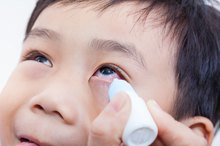A Swollen Eyelid in a Child
Children often have swollen eyelids, commonly caused by trauma, infection and allergies. Because these conditions can be serious, consult your child's pediatrician for an accurate diagnosis and treatment plan to avoid damage to your child's eye or vision.
Infection
Bacteria and viruses are the most common infectious causes of swollen eyelids in children. Conjunctivitis, or pinkeye, is a common infection of the white part of the eye that can cause eyelid swelling. It typically starts as redness with a whitish or yellowish discharge from the eye. Your child's eyes may itch or burn, and produce extra tears. Conjunctivitis is highly contagious, and easily spread to other children due to poor hand-washing techniques. Bacterial conjunctivitis is treated with topical medication 3. Viral conjunctivitis typically resolves on its own within 3 to 5 days.
- Bacteria and viruses are the most common infectious causes of swollen eyelids in children.
- Conjunctivitis, or pinkeye, is a common infection of the white part of the eye that can cause eyelid swelling.
Cellulitis
Bloodshot Eyes in Children
Learn More
Periorbital and orbital cellulitis can also cause eyelid swelling. Periorbital cellulitis is a bacterial infection that is typically preceded by a sinus infection in children. Bacteria infect the skin around the eye, including the eyelid. This condition can worsen and progress into orbital cellulitis if the infection goes behind the eye, causing an abscess. Other symptoms include blurred vision, redness, headache, double vision and bulging of the eyes. Periorbital cellulitis requires antibiotics, but orbital cellulitis may need longer term intravenous antibiotics or surgical intervention. Seek medical attention immediately if your child has these symptoms -- although rare, orbital cellulitis can cause loss of vision or even death.
- Periorbital and orbital cellulitis can also cause eyelid swelling.
- This condition can worsen and progress into orbital cellulitis if the infection goes behind the eye, causing an abscess.
Trauma
Direct trauma to the eye can also cause eyelid swelling. In children, trauma to the eye is commonly caused by pencils and other sharp objects, tree branches and flying toys. Insect bites can cause trauma to the area, especially from mosquitoes and ticks. Even if the eye does not appear to be directly affected, contact your child's pediatrician to be sure. Corneal abrasions -- scratches on the protective covering of the eye -- typically heal within 24 to 72 hours after the injury. You child's doctor may prescribe topical anti-inflammatory medication to reduce pain as the eye heals.
- Direct trauma to the eye can also cause eyelid swelling.
- In children, trauma to the eye is commonly caused by pencils and other sharp objects, tree branches and flying toys.
Allergies
Pediatric Puffy Eye and Congestion
Learn More
Allergies are another common cause of swollen eyelids. During allergy season, susceptible children can get watery, itchy eyes. Children can also have allergic reactions to medicines, food products and detergents. Frequent rubbing to decrease the itching sensation can result in swelling. Also, children can get allergic shiners -- dark circles under the eyes as a response to chronic seasonal allergies. These circles can extend to the eyelid, increasing the swelling and inflammation in the area.
- Allergies are another common cause of swollen eyelids.
- These circles can extend to the eyelid, increasing the swelling and inflammation in the area.
Warning
Seek medical attention for a proper diagnosis of the cause of your child's swollen eyelid. Contact your doctor immediately if the swelling is so severe that it completely covers the eye, the child complains of pain on opening the eye or when trying to move the eye, or the swelling is accompanied by other symptoms, such as a high fever or loss of vision.
Related Articles
References
- American Family Physician: Differential Diagnosis of the Swollen
- Middle East African Journal of Ophthalmology: The Hot Orbit -- Orbital Cellulitis
- Clinical Ophthalmology: Bacterial Conjunctivitis
- Canadian Family Physician: Topical Nonsteroidal Anti-Inflammatory Drugs for Corneal Abrasions in Children
- Sami MS, Soparkar CN, Patrinely JR, Tower RN. Eyelid edema. Semin Plast Surg. 2007;21(1):24-31. doi:10.1055/s-2007-967744
- Lindsley K, Nichols JJ, Dickersin K. Interventions for acute internal hordeolum. Cochrane Database Syst Rev. 2010;(9):CD007742. doi:10.1002/14651858.CD007742.pub2
- Azari AA, Barney NP. Conjunctivitis: a systematic review of diagnosis and treatment. JAMA. 2013;310(16):1721-9. doi:10.1001/jama.2013.280318
- Lee S, Yen MT. Management of preseptal and orbital cellulitis. Saudi J Ophthalmol. 2011;25(1):21-9. doi:10.1016/j.sjopt.2010.10.004
- Girgis CM, Champion BL, Wall JR. Current concepts in graves' disease. Ther Adv Endocrinol Metab. 2011;2(3):135-44. doi:10.1177/2042018811408488
- Barker NH. Ocular herpes simplex. BMJ Clin Evid. 2008;2008:0707.
- Sowka, Joseph W., Andrew S Gurwood and Alan G Kabat. The Handbook of Ocular Disease Management, Twelfth Edition, 15 April 2010, Supplement to Review of Optometry.
Writer Bio
Ruben J. Nazario has been a medical writer and editor since 2007. His work has appeared in national print and online publications. Nazario is a graduate of the University of Louisville School of Medicine, and is board-certified in pediatrics. He also has a Master of Arts in liberal studies from Skidmore College in Saratoga Springs, N.Y.









